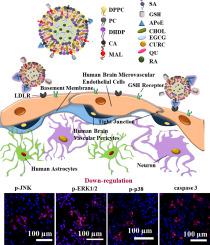Biomaterials Advances ( IF 5.5 ) Pub Date : 2021-06-10 , DOI: 10.1016/j.msec.2021.112233 Yung-Chih Kuo, I-Wen Ng, Rajendiran Rajesh

|
Neurodegenerative disorders, such as Alzheimer's disease (AD), present biomedical challenges due to inability of pharmaceuticals to permeate the blood-brain barrier (BBB) and lack of therapeutic specificity in definite sites against multiple pathologies. Phosphatidylcholine (PC)-liposomes carrying curcumin (CURC), quercetin (QU), epigallocatechin gallate (EGCG) and rosmarinic acid (RA) with crosslinked glutathione (GSH) and apolipoprotein E (ApoE) were fabricated to recognize brain microvascular endothelial cells and amyloid beta (Aβ), and reduce tau protein hyperphosphorylation for AD management. Addition of stearic acid to liposomal bilayers ameliorated particle stability, promoted drug entrapment efficiency, and prolonged drug release duration. The triple targeting liposomes boosted the capability of CURC, QU, EGCG and RA for crossing the BBB with the assistance of grafted GSH and ApoE and docking Aβ around SK-N-MC cells using ApoE and PC. Moreover, GSH-ApoE-PC-liposomes benefited the 4 medicines in simultaneously transporting to Aβ1–42-insulted neurons, in functioning against hyperphosphorylated mitogen-activated protein kinases, including p-c-Jun N-terminal protein kinase, p-extracellular signal-regulated protein kinase 1/2 and p-p38, in downregulating tau protein at S202, caspase-3 and interleukin-6, and in upregulating p-cyclic adenosine monophosphate response element-binding protein. GSH-ApoE-PC-liposomes can be promising colloidal carriers in delivering CURC, QU, EGCG and RA to degenerated neural tissue in a controlled manner, targeting pathological factors for neuroprotection, and raising preclinical effectualness for AD treatment.
中文翻译:

谷胱甘肽和载脂蛋白 E 移植脂质体调节丝裂原活化蛋白激酶和拯救阿尔茨海默病中的神经元
神经退行性疾病,例如阿尔茨海默病 (AD),由于药物无法渗透血脑屏障 (BBB) 以及在特定部位缺乏针对多种病理的治疗特异性,因此面临生物医学挑战。磷脂酰胆碱 (PC)-脂质体携带姜黄素 (CURC)、槲皮素 (QU)、表没食子儿茶素没食子酸酯 (EGCG) 和迷迭香酸 (RA) 与交联谷胱甘肽 (GSH) 和载脂蛋白 E (ApoE) 用于识别脑微血管内皮细胞和淀粉样蛋白β (Aβ),并减少用于 AD 管理的 tau 蛋白过度磷酸化。将硬脂酸添加到脂质体双层改善了颗粒稳定性,提高了药物包封率,并延长了药物释放持续时间。三重靶向脂质体提高了CURC、QU、EGCG 和 RA 在移植的 GSH 和 ApoE 的帮助下穿过 BBB,并使用 ApoE 和 PC 在 SK-N-MC 细胞周围对接 Aβ。此外,GSH-ApoE-PC-脂质体有利于4种药物同时转运至Aβ1 – 42受损伤的神经元,对过度磷酸化的丝裂原活化蛋白激酶发挥作用,包括 pc-Jun N 端蛋白激酶、p-细胞外信号调节蛋白激酶 1/2 和 p-p38,在 S202 下调 tau 蛋白, caspase-3 和 interleukin-6,以及上调 p-环磷酸腺苷反应元件结合蛋白。GSH-ApoE-PC-脂质体可作为一种很有前景的胶体载体,以受控方式将 CURC、QU、EGCG 和 RA 输送到退化的神经组织,靶向病理因素进行神经保护,并提高 AD 治疗的临床前效果。











































 京公网安备 11010802027423号
京公网安备 11010802027423号